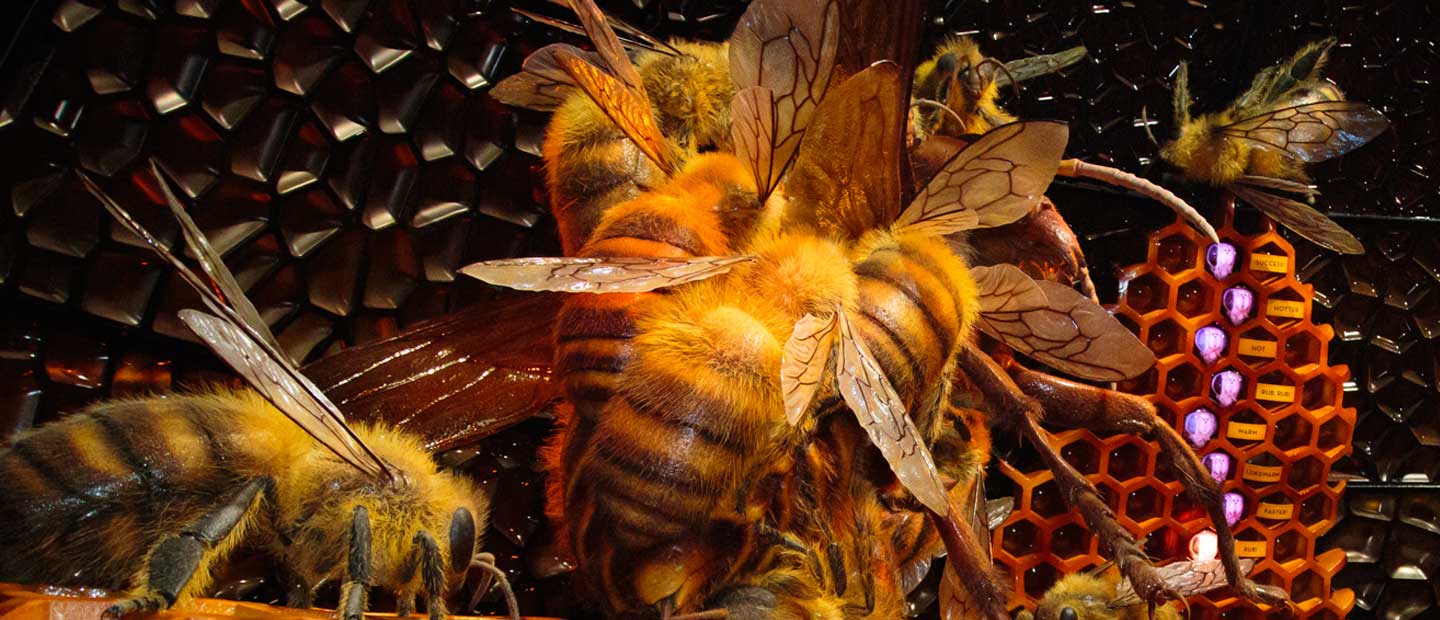The Swarm area of Bug Lab looks at swarms and social insects. Our stars of the swarm area Japanese honey bees and looks at their life and death struggle with the thumb-sized Japanese giant hornet. Japan is also home to European honey bees that were introduced because they produce more honey than local species. However, when the giant hornets come calling, the European bees have no chance. The hornets are usually solitary, but if they find a bee hive, they’ll release a chemical marker to attract more of their kind. What follows is carnage. Thirty hornets will slaughter tens of thousands of bees in a matter of hours. The bees can’t do anything as the hornets are too strong and too well-protected to be stung. The hornets literally rip the bees apart to make a banquet for their own young.
But that’s not true for all bees. Unlike their European counterparts, Japanese honeybees have evolved alongside the giant hornet and have a clever trick to defend their hive. When a hornet scout arrives, the bees at the hive entrance release a chemical signal called a pheromone to summon more workers. They lure the hornet inside and then another pheromone triggers the defence. The bees swarm all over the hornet, covering it in a living blanket. Then they start furiously vibrating their flight muscles. This creates carbon dioxide and heat, with the temperature under the bee-blanket rising to a lethal level for the hornet but it’s still a degree or two less than the bees can stand. By working together, the bees cook the hornet and the hive is saved! Vibration of the wing muscles is one method for warming up the hive, so you might say these bees have weaponised air conditioning.
Weta workshop have captured this epic struggle in all its hairy detail (it took over 200 hours to put the hairs on the bees!) and the best part is that if you visit Bug Lab, you can help the bees in their battle. There are a heat pads that need to be rubbed fast to warm them up. Raise the temperature high enough and you’ll win. You can’t do it alone. You’ll have to cooperate with others like the bees to achieve victory.
Dr Phil SirvidVibration of the wing muscles is one method for warming up the hive, so you might say these bees have weaponised air conditioning!
Swarms and social insects show how the combination of large numbers of bugs and a set of context-based behavioural “rules” can generate mind-boggling complexity. Australians are familiar with giant termite mounds several metres high and occupied by millions of blind termites. How does such a thing come to be if no termite has a plan in its head for what the overall structure looks like? Putting it very simply, each termite on building duty carries out its work based on the situation it finds itself in. Whether it’s building up or across, the conditions in the immediate vicinity govern what they do next.
This is the inspiration behind the TERMES robots from Justin Werfl and some talented engineering colleagues over at Harvard University. They’ve made small robots that can take blocks from a stack and build structures with them. Like termites, they have rules to follow but no vision of the finished structure and are all acting independently of one another. A robot will determine whether to stack a block next to or on top of another based on what it finds when it gets there. It will head somewhere else if there is nowhere to put the block. Ultimately, the right shaped stack is made by robots that have no idea what they’re building, but are following the right rules to make it happen. Perhaps one day bigger and better TERMES-like robots will revolutionise construction, especially in places that are too dangerous to send humans.
Bug swarming and other group behaviours have a lot to teach us and we’re already learning. The Lord of the Rings movies used a program called Massive to organise thousands of individual CGI warriors in epic battle scenes. Swarm organization is also a promising area of research for traffic control in the broad sense. It could be efficiently routing packets of data over a network. In the not so distant future you might be sitting in a convoy of driverless cars swiftly making their way down the motorway with near perfectly coordinated speed and spacing.
Dr Phil Sirvid looks after the entomology collection at Te Papa and has an inordinate fondness for spiders. He is one of the swarm of people that helped develop the Bug Lab exhibition.

Bug Lab
EXHIBITION
Coming to Auckland Zoo from the 20th of December, Bug Lab is a blockbuster science exhibition developed by New Zealand’s world-famous museum, Te Papa, with the Academy Award© winning Weta Workshop. Tickets on sale now.






